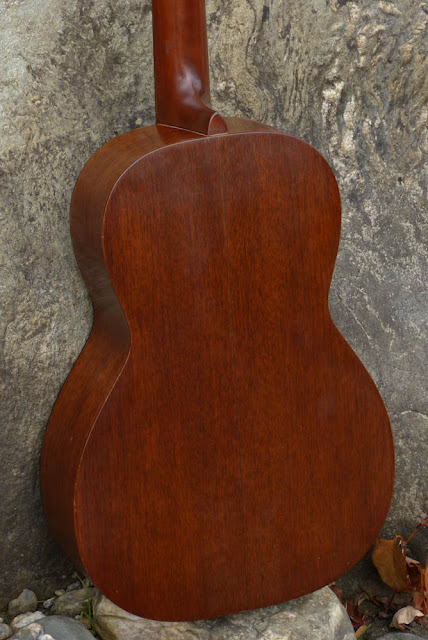1969 Martin 0-16NY "New Yorker" Flattop Guitar
This nice old 12-fret "0" has more in common with a 1930 Martin 0-18 than it does with any of its nearest contemporaries. It's built light, light, light, light and as such shares the same rewards as that old 0-18 as well as the downfalls. As a fingerpicker using the lightest-gauge steel strings it sounds blissful, warm, sweet, and full. As a flatpicker -- because of those necessarily-light gauges -- it still sounds swell but loses a lot of the straight-up fullness you hear fingerpicked.
The other "devil" in the design is that the very light bracing tends to mean the top develops a significant belly unless extra-light (10s or lighter) strings are used. These were, afterall, designed for nylon/gut or "silk and steel" only, though modern 46w-10 strings have just a hair less tension than your average silk and steel set. This one had a big old belly when it came in -- and a falling-off original (rectangular) bridge.
A customer brought this to me for work and so I replaced that original (warped)
bridge with a belly bridge, very light spruce bridge plate cap/support,
gave it a fret level/dress, re-shaped and re-used the original (ivory?) saddle on the new bridge, swapped the tuners for some StewMac repros, and set it all up.
It came out of work sounding dead-on close to that aforementioned 1930 0-18 and playing just as well, too (spot-on). The new Martin-style belly bridge stabilized the top and removed a lot (but not all) of the belly, to boot.
1 7/8" nut width and a mild C/V hybrid neck profile.
Martin's style 16 meant no fretboard inlay and no back-edge binding. These set it at a lower price point/detailing point compared to the 14-fret 0-18s sold at the same time. It also has an (original) satin finish compared to the gloss of an 18-series instrument.
The big pickguard is, of course, unoriginal. It was added by the owner's father many moons ago.
The new belly bridge is handsome enough and should be much more practical in keeping the top healthy than the original rectangular bridge. The top was quite thin and a little damaged in this area from a previous bridge reglue that failed and so using a bridge with a bit of extra "hold" seemed a top priority during repairs.
While the pries for old 0-16NY models seem to keep climbing, they're still great buys for anyone wanting to replicate that 1930s 12-fret Martin sound without laying-down the steep cash or fussing with someone a bit too "dear" structurally.
The new StewMac "Golden Age" reproduction tuners are tighter and nicer than the original-spec tuners which were themselves pseudo-copies of the original 1920s/30s tuners found on antique Martins. The originals are, of course, stashed in the case to go back to the owner.
















Comments